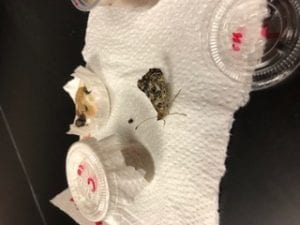The links attached are to the two claymation videos we created on cell signaling in class.
Questions:
- How are these two systems similar? Consider both structural similarities and similarities in how the systems function.
- Both of these systems have plasma membrane receptors. In both pathways, a signal begins to be sent as a signal molecule binds to a receptor within the cell’s membrane. They are also similar in the ways they handle Ca+ (calcium) ions. In both systems, the second messenger (IP3) diffuses through the cytosol of the cell and binds with an IP3-gated calcium channel in the ER (endoplasmic reticulum). The Ca+ ions will then move out of the ER, down their concentration gradient, raising the Ca+ concentration in the cytosol. The ions then activate the next protein in the pathway. This process occurs in both cells.
- How are these two systems different? Consider both structural differences and differences in how the systems function.
- Their overall processes of cell signaling are different. They also have different amounts of receptor proteins in a pathway. G-Protein coupled receptors are visually much more simple, whereas tyrosine kinase receptors have bits of tyrosine attached on one side. Each process will signal for different things to occur as well.
- Both systems can generate elaborate multistep signal transduction pathways. These pathways can greatly amplify the cell’s response to a signal; the more steps in a pathway, the greater the amplification of the signal. Explain how this amplification can occur.
- The example I will use here is the breakdown of glycogen by epinephrine. This amplification occurs as the hormone epinephrine acts through the G-Protein coupled receptor, activating a succession of relay molecules. These include cAMP and two protein kinases. The final protein in the chain is activated by the enzyme glycogen phosphorylase. This enzyme uses an inorganic phosphate molecule to release the monomer glucose from its polymer, glycogen. These are released in the form of glucose-1-phosphate. The hormonal signal is then amplified because the one receptor can activate a hundred molecules of a G-Protein. Each enzyme can act on many substrate molecules.
11.1: Test Your Understanding
Humans have the ability to detect and recognize many different aromatic chemicals by smell. Many of these chemicals are present in concentrations less than 1ppm (part per million) in the air. For example, the majority of humans can detect and recognize chlorine at a concentration of about 0.3ppm .
a. What characteristics of olfactory (smell) receptors would you look for on purpose to explain this ability?
- One should look for a longer signal-transduction pathway. With more steps, more enzymes can pass a signal to even more substrate molecules. This means even a small concentration of an aroma will set off a signal, and it will be passed along quickly enough that the small concentration can be detected strongly. The amplification must be very high for one to be able to recognize the scent of something in such a small concentration with ease.
b. Dogs are known to have a much better sense of smell than humans. Given this, what differences may exist in their olfactory system (as compared to humans)?
- They likely have even more pathways or longer pathways for signal transduction. Aromatic chemicals can be detected very easily by dogs, therefore the amplification of the cell’s response to these signals is greater than that of humans. So, they must have a greater amount of signal transduction pathways or longer signal transduction pathways.
